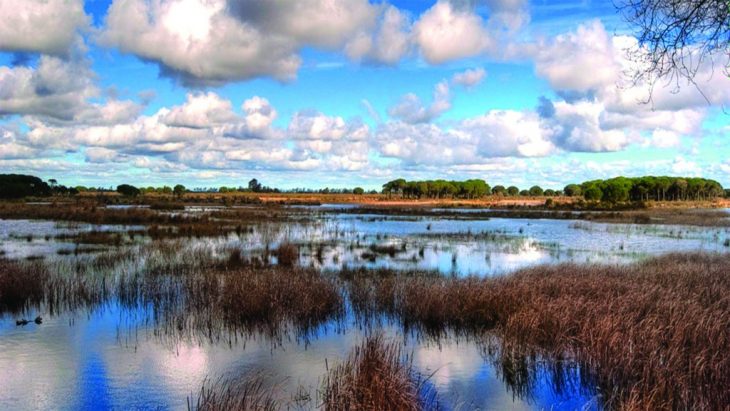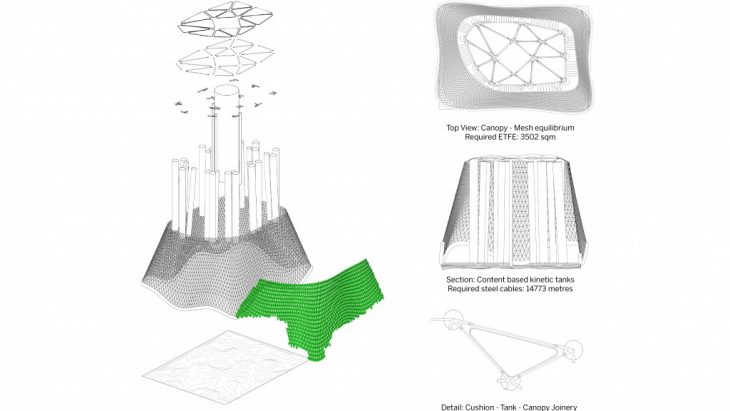THE BIOREFINERY
KINETIC TANK FOREST
Can we design a system that can create an ecosystem?
Can cities start coexisting with nature ?
If so can we achieve this retrofitting with as little resources as possible?
This experiment of urban transformation through system design is located in Barcelona’s neighbourhood of Poblenou. In past decades Poblenou has served as the city ‘s urban lab where different urbanistical plans and approaches have been tested. The Biorefinery project is located in the middle of the 22@ district, next to the Superilla, Barcelona’s first approach into a carless future.
Once the public space has been reclaimed from cars, is it possibe to give it back nature?

WASTE
The Biorefinery is a research facility that aims to mine its surroundings prevalent waste, transform it into valuable goods and in doing so transform this carless district into a flourishing Wetland.
Waste as Gunther Pauli states in his book “The Blue Economy“ is just resourses we don’t know ho to use. What is the most under utilised resource humans produce in abundance and is seldom exploited?
The answer is feces. On a daily basis a human being in the developed world produces 80 litres of sewage, taking into accont the water used for this process. From this starting point is that the system for the biorefinery was developed.
Mapping the surrounding buildings, 13 office buildings and hotels were identified within a 3 block radius. In turn a study was elaborated to estimate the daily sewage production of these buildings. It was calculated that only these 13 buildings produce an estimate of 1.28 million litres of sewage per day.
What are the processes that can be designed to extract the maximum value from these resources without harming the environment? How can we do more with less?





THE SYSTEM
Daily sewage goes into a main low retention time anaerobic digester where it is fermented and broken down by bacteria during a 10 day period. During this process bacteria feed on the sewage and in turn produce biogas, solid slurry and water. The biogas is then run through a carbon filter to separate the different components of the gas and obtain high grade quality methane and separate it from the carbon dioxide.
Methane is burned in generators to produce energy an heat, and the resulting carbon dioxide from the combustion is stored with the rest produced from the biogas.
The slurry is further composted in an aerobic process to eliminate remaining pathogens and is then used as a substrate for mushroom production. The spent medium then can be used as high protein animal feed or used as a growing medium food crops.
The water and carbon dioxide are mixed and constanly cycled to grow algae which purify the water and produce high quantities of biomass trapping the carbon dioxide. This biomass can then be refined into fuel, oil, plastics or food.
After this process is done 1.28 million litres of clean water come out daily giving rise to the emergence of the wetland. Instead of pumping this clean, but not potable water down the drain it is distributed on site to promote the formation of a wetland.
The building in turn serves as a research facility where knowledge is constantly produced based on the experiences and process carried out in the Biorefinery. Instead of serving as an educational facility where old models are replicated and perpetuated, the Biorefinery is a factory of new knowledge investigating new ways and processes that can lead us into a cleaner and more hollistic future, where we are able to existit with the rest of the living creatures of this planet with harming the environment.


SHAPING THE SYSTEM

ALGORITHMIC OPTIMISATION
Once the design parameters were established an evolutionary genetic algorithm was used to find the optimal configuration for the building according to some pre established goals or aims.
The code was elaborated to find the optimal configuration of tanks within the building so as to obtain a perimetral mesh with the maximum area of high solar radiation where algae panels will be distributed for biomass production.

THE STRUCTURE
In the Biorefinery the structure is indivisible from the system, the infrastructure developed also serves as the main support for the building.
The system created is a system of flows and transformation and in an attempt to make this processes as visible and performative as possible the structure becomes kinetic according to the content and flows of materials in the system. Make it visible is the driving motto and thus infrastructure becomes structure which becomes performance.
The resulting structure is a performative oscillating kinetic envelope in constant tensile equilibrium. A kinetic forest of tanks kept in balance by an inflated ETFE cushion canopy that adjust itself to the oscillations, and a perimetral mesh that ties everything together completing the equilibrium.
In this way the system becomes the structure and the internal components, water, gas and nutrients reshape and transform the building as they flow from one state to the next.

CONNECTING THE SYSTEM
To become connected to the wider net of the city without using hard infrastructure the Wetland is sunk an average of 3 metres to connect to the lower freatic water levels, thus becoming interconnected to the wider net of natural flows of water of Barcelona.

THE BIOREFINERY




THE BIOREFINERY The Biorefinery is a project elaborated for the Self Sufficient Buildings Studio 2016-2017 in the Master of Advanced Architecture at the Institute of Advanced Architecture of Catalunya
PROJECT BY: Sebastian Amorelli
TUTORS: Enric Ruiz-Geli, Mireia Luzarraga